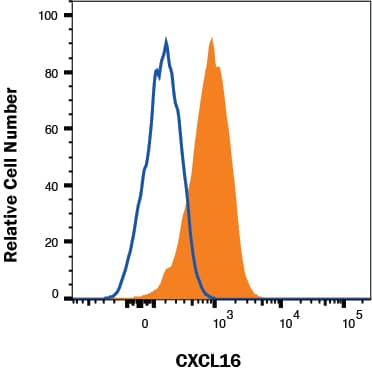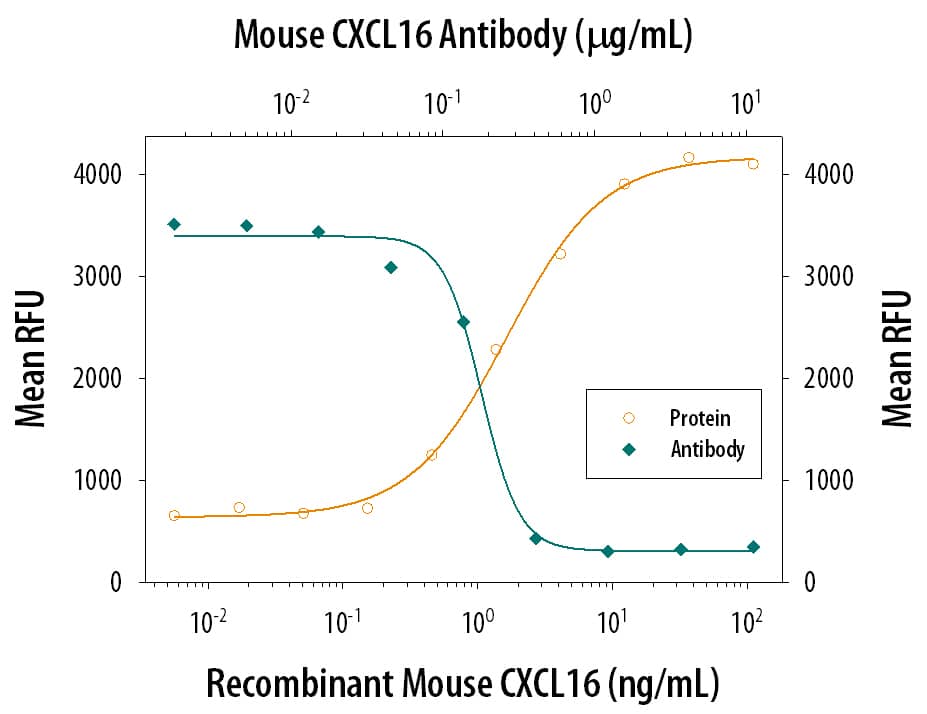Mouse CXCL16 Antibody
R&D Systems, part of Bio-Techne | Catalog # AF503


Key Product Details
Species Reactivity
Validated:
Cited:
Applications
Validated:
Cited:
Label
Antibody Source
Product Specifications
Immunogen
Asn27-Pro114
Accession # Q8BSU2
Specificity
Clonality
Host
Isotype
Endotoxin Level
Scientific Data Images for Mouse CXCL16 Antibody
Detection of CXCL16 in Raw 264.7 cells by Flow Cytometry
Raw 264.7 cells were stained with Goat Anti-Mouse CXCL16 Antigen Affinity-purified Polyclonal Antibody (Catalog # af503, filled histogram) or isotype control antibody (Catalog # AB-108-C, open histogram) followed by Allophycocyanin-conjugated Anti-Goat IgG Secondary Antibody (Catalog # F0108). View our protocol for Staining Membrane-associated Proteins.Chemotaxis Induced by CXCL16 and Neutralization by Mouse CXCL16 Antibody.
Recombinant Mouse CXCL16 Chemokine Domain (Catalog # 503-CX) chemoattracts the BaF3 mouse pro-B cell line transfected with mouse CXCR6 in a dose-dependent manner (orange line). The amount of cells that migrated through to the lower chemotaxis chamber was measured by Resazurin (Catalog # AR002). Chemotaxis elicited by Recombinant Mouse CXCL16 Chemokine Domain (7.5 ng/mL) is neutralized (green line) by increasing concentrations of Goat Anti-Mouse CXCL16 Antigen Affinity-purified Polyclonal Antibody (Catalog # AF503). The ND50 is typically 0.1-0.4 µg/mL.Applications for Mouse CXCL16 Antibody
CyTOF-ready
Flow Cytometry
Sample: Raw264.7 mouse monocyte/macrophage cell line
Western Blot
Sample: Recombinant Mouse CXCL16 Chemokine Domain (Catalog # 503-CX)
Neutralization
Reviewed Applications
Read 2 reviews rated 5 using AF503 in the following applications:
Formulation, Preparation, and Storage
Purification
Reconstitution
Formulation
*Small pack size (-SP) is supplied either lyophilized or as a 0.2 µm filtered solution in PBS.
Shipping
Stability & Storage
- 12 months from date of receipt, -20 to -70 °C as supplied.
- 1 month, 2 to 8 °C under sterile conditions after reconstitution.
- 6 months, -20 to -70 °C under sterile conditions after reconstitution.
Background: CXCL16
Mouse CXCL16 (CXC chemokine 16) is a non-ELR motif-containing CXC chemokine with a transmembrane domain. CX3CL1/Fractalkine and CXCL16 are the only two transmembrane chemokines within the superfamily. Mouse CXCL16 cDNA encodes a 246 amino acid (aa) precursor protein with a putative 26 aa residue signal peptide, an 88 aa residue chemokine domain, an 87 aa residue mucin-like spacer region, a 22 aa residue transmembrane domain, and a 23 aa residue cytoplasmic tail. Mouse and human CXCL16 share 49% overall aa identity and 70% similarity in the chemokine domains. Mouse CXCL16 is produced by dendritic cells in lymphoid organ T cell zones and by cells in the splenic red pulp both as membrane-bound and soluble forms. Based on northern blot analysis, CXCL16 is also expressed in some nonlymphoid tissues such as lung, small intestine and kidney. The receptor for CXCL16 has been identified as CXCR6/Bonzo (STRL33 and TYMSTR), a receptor previously shown to be a co-receptor for HIV entry. CXCR6 is expressed on naive CD8 cells, natural killer T cells and activated CD8 and CD4 T cells.
Alternate Names
Gene Symbol
UniProt
Additional CXCL16 Products
Product Documents for Mouse CXCL16 Antibody
Product Specific Notices for Mouse CXCL16 Antibody
For research use only
